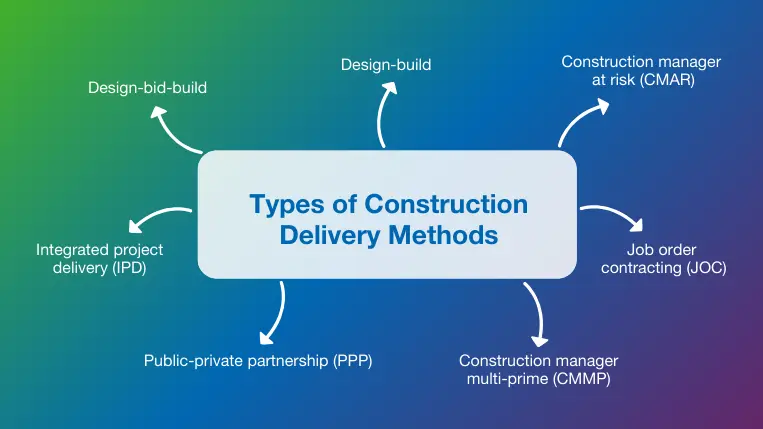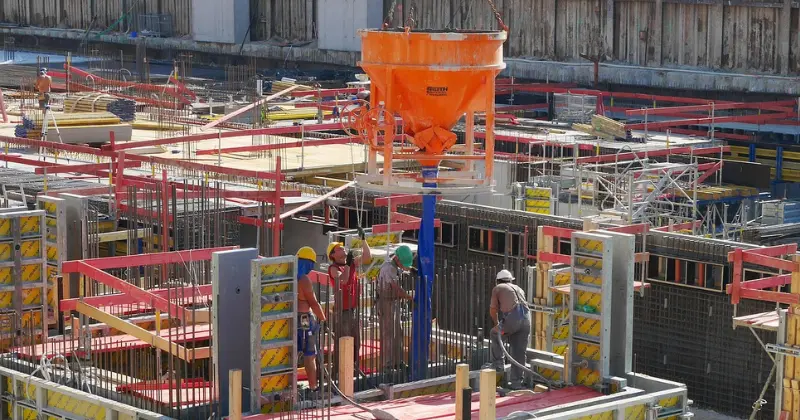10 mins read
Construction Delivery Methods: Key Strategies and Best Practices

In the construction industry, delivery refers to the manner in which contractual obligations for the design and project completion are assigned and carried out. Each construction delivery method creates a different set of relationships between stakeholders while bringing its own unique benefits and challenges.
This blog post reviews the most common construction delivery methods, their pros and cons, and some factors to consider when selecting the right option for your project. We also provide some useful tips and strategies for effective construction delivery management. Let’s get started!
Types of Construction Delivery Methods

Contractors, designers, and project owners continue to develop new construction delivery types to offer greater flexibility and improve the flow of work. The most used methods today include:
Design-bid-build
As the name implies, the design-bid-build (D-B-B) method consists of a design, bidding, and construction (build) phase. This traditional method remains the most popular option. Construction drawings and specifications completed by designers and architects define the project scope and provide the necessary information to solicit contractor bids. The bidding phase includes collaboration and negotiations to ensure an efficient and coordinated build phase.
The lower building costs that result from a competitive construction bidding process are one advantage of the D-B-B method, and the separation of construction and design activities is another since it provides a set of checks and balances for both parties. On the other hand, the lengthy review and bidding cycles that must be completed before work begins can delay project start dates.
Design-build
The design-build (D-B) method addresses the time constraint associated with the D-B-B method by eliminating the bidding phase altogether. This is made possible by hiring a design-builder to complete both project phases based on their comprehensive project proposal rather than handing off tasks to third-party contractors selected through bidding.
The design-build process brings speed and efficiency by placing the entire project under one agreement. This model can make the handoffs to subcontractors smoother and accelerate project start dates. At the same time, this method puts all responsibilities in the hands of a single company, which introduces more risk for the project owner.
Construction manager at risk (CMAR)
The construction manager at risk (CMAR) method is like the traditional D-B-B model but places the leadership of all construction project delivery tasks in the hands of the same construction manager (CM) throughout all phases. The CM is responsible for managing costs and overseeing construction from beginning to end, which minimizes delays due to handoffs.
The risk element of CMAR is introduced when construction managers must absorb costs that are higher than expected. Additional challenges come from balancing the concerns of individual designers and contractors when there is no direct contract between them. The CMAR method is most beneficial for busy owners willing to place a high level of trust in a competent CM.
Construction manager multi-prime (CMMP)
The long name of this construction project delivery method refers to instances where the owner acts as the project’s general contractor. In a reversal of the CMAR method, the owner takes full responsibility for overseeing design details and specifications, hiring subcontractors, and ensuring timely project completion.
One obvious benefit of this method is the elimination of one or more intermediaries, which gives the owner direct insight into the project budget, schedule, and risk factors. Owners with the time and experience to assume this role themselves can improve visibility and reduce project management expenses. Still, complex projects can also create a stressful situation for owners overseeing many individual contracts and tasks.
Job order contracting (JOC)
Also known as indefinite-delivery, indefinite-quantity (IDIQ), job order contracting (JOC) is an approach where multiple projects are awarded under one blanket contract. Using the JOC method, tasks and materials might also be assigned pre-set pricing based on a Construction Task Catalog (CTC). This eliminates time-consuming bidding and administrative processes while keeping price expectations transparent.
The benefits of this approach are minimized when projects vary in scope or complexity, making it difficult to agree on fixed pricing models. The JOC method works best for small- or medium-sized projects, such as multi-unit residential development, with tasks that are repeated many times.
Public-private partnership (PPP)
The PPP (P3) construction project delivery method refers to instances where a public entity works with a private contractor to complete the project. This type of partnership is common when government funds are allocated for construction and private third parties are called upon to complete the project according to agreed-upon contract terms. The process typically mirrors a D-B-B delivery flow, with government restrictions such as prevailing wage regulations shaping the project budget and flow.
The PPP model can be a winning combination of reliable government funding sources and private construction expertise. When bid bonds are used to secure projects, this provides an added layer of security for contractors as they complete their billing and payment cycles. However, like entirely private partnerships, delays, and funding issues are still possible when government priorities change.
Integrated project delivery (IPD)
IPD is among the newer construction delivery methods based on lean construction principles that improve collaboration between project owners, designers, and contractors throughout the project lifecycle. Unlike more traditional models, all team members are selected before the project begins, each taking on an equal share of project risk.
Improved collaboration and communication in construction projects are the greatest benefits of the IPD method since early involvement reduces the number of handoffs and leadership changes. Although this method is already being deployed successfully, establishing a cross-functional team and a new system early on requires a dedication to digital project management and planning tools.
Factors to Consider When Selecting a Construction Delivery Method
What is the best way to choose the right construction project delivery methods? There is no formula to make this decision easier, but the project scope, timeline, and budget must all be considered. For example, a large infrastructure project with a design firm that does not perform its own construction tasks might align with a traditional design-bid-build model. In contrast, projects with predictable requirements and repeat purchases can be expedited through construction delivery types like D-B and JOC. Additional factors to consider include:
- Importance of start and completion dates to overall project success
- Level of collaboration required between designers and contractors
- Experience, expertise, and availability of the project owner
Construction risk management tools can be useful in weighing delivery alternatives and determining what potential construction issues, safety hazards, or expenses might be introduced depending on the method selected.
Tips for Effective Construction Delivery Management

Choosing the right construction delivery method is always important, but established best practices help to safeguard project success and timely completion no matter what model is utilized.
1. Establish accurate budgets and schedules
An accurate schedule points out critical path tasks, while accurate quantity takeoffs and estimates based on the latest information ensure the budget can be maintained even when scope changes or contingencies alter the plan. This attention to detail is especially important when construction delivery methods eliminate the bidding process in the interest of time.
2. Implement lean construction delivery methods
Lean methods do not always require wholesale changes in project management or leadership tactics. The primary goals of improved efficiency and reduced waste can be pursued during each project phase using any construction delivery method. For example, the D-B-B method provides an opportunity to reduce waste through competitive bidding cycles, while the JOC method improves efficiency by establishing fixed pricing standards.
3. Quality control and quality assurance
Construction quality control involves verifying project tasks to ensure successful completion, while quality assurance is based on establishing systems that will guarantee superior quality, even without verification. Accountability can shift between stakeholders depending on the delivery methods in construction projects, but including well-defined quality requirements in the contract ensures key deliverables are always within acceptable limits.
4. Use professional construction management software
As new construction delivery methods emerge, construction software solutions are the key to implementing new processes like IPD that require close collaboration and document sharing. Digital solutions also boost traditional methods such as D-B-B that call for efficient design, bidding, and estimating cycles to minimize delays. Cloud-based software keeps all stakeholders on the same page while improving efficiency through automated workflows and real-time data access.
Conclusion
Speed and quality are the markers of success for any type of delivery. Digital tools allow architects, designers, and contractors to link the right construction delivery methods with the practices and collaboration platforms that optimize their effectiveness.
At RIB, we offer a professional toolkit of solutions that simplify key project workflows and put real-time data in the decision-maker’s hands during important scheduling, estimating, bidding, and project management tasks. If you are ready to join the thousands of companies who already trust our solutions, get your demo today and discover how RIB can transform your business!
Most Recent
10 mins read
11 mins read
11 mins read
10 mins read
Blog Categories

Ebook











